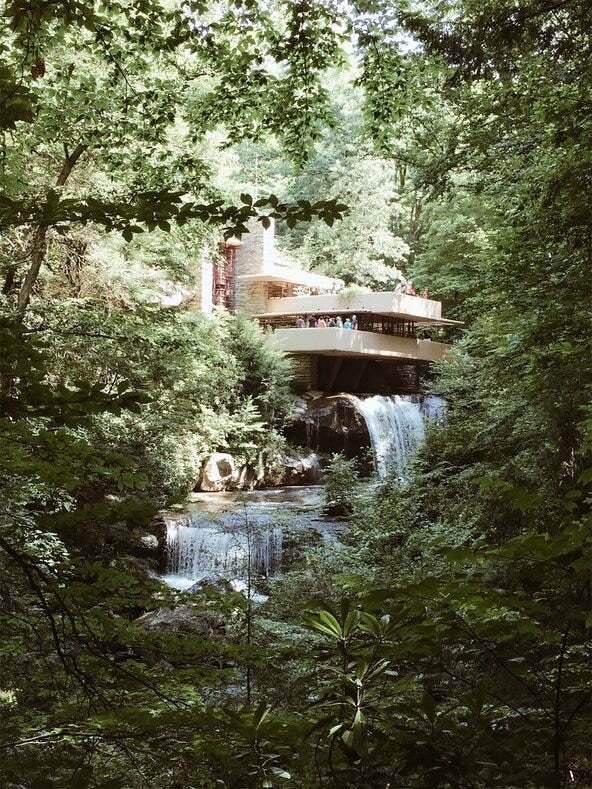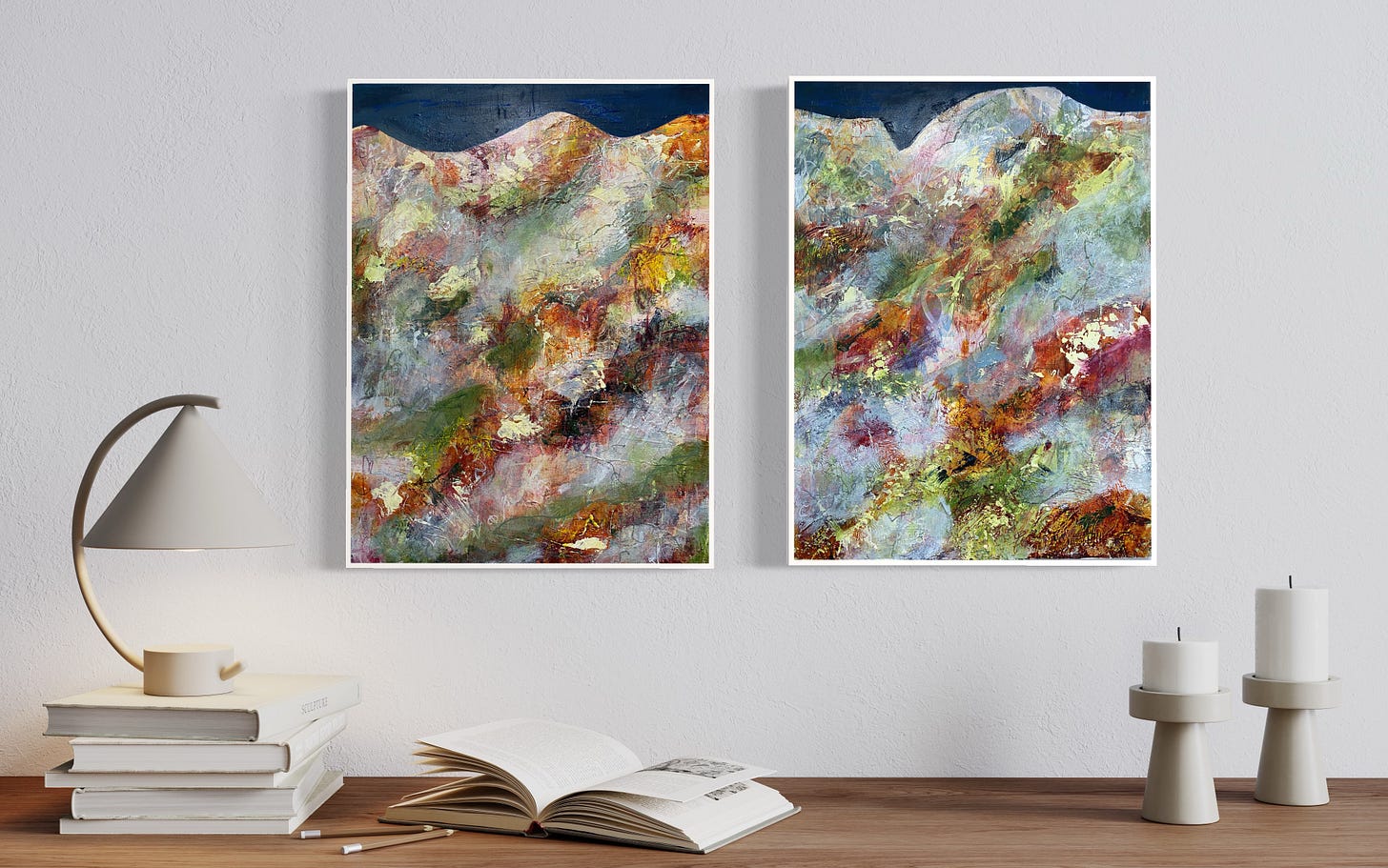How to build a stable creative life.
The power of choosing to move forward on the level rather than progressing ever upward on shaky foundations
A creative mind finds life truths not in facts but in the connections between facts. This, I told my husband today, is why still being in my pyjamas at 11 am on a so-called workday was totally justified because you have to do something to actually find those varied facts in the first place. I was reading a book called A Harp in the Stars, An Anthology of Lyric Essays, ostensibly to learn about how to construct segmented, flash or hermit crab essay forms. But somewhere in the doing of that I got sucked into the architecture of Frank Lloyd Wright, in particular his love of horizontal lines.
Photo by Claudia Lorusso on Unsplash
Living as I do in a post-industrial town in North West England, I have never walked through an example of his Prairie style architecture but I understand now that he found his style in opposition to the conglomeration of imported styles brought from overseas to America.* He saw the jumble of Italianate, Empire and Gothic mansions and felt ‘a yearning for simplicity’. It was not only a simplicity of line his soul yearned for but also a simplicity of authenticity. He wrote that these relocated buildings “lied about everything. [They have] no sense of unity… to take any one of those so-called ‘homes’ away would have improved the landscape and cleared the atmosphere…”
In response he designed homes with horizontal lines to the forefront. Grout was scraped out from between the bricks on the horizontal lines and left flush with the brick on the vertical. Windows were thin and long. Cypress siding was placed parallel to the ground. The result, according to one home owner was that the lines “guide your eye, contain your thoughts, and quiet your mind” As Katherine Hillbrand says of her own Lloyd Wright inspired house design “because the horizontal line “lies down”, so to speak, it appears to be at rest, and embodies tranquility… We innately feel reassured that such a building is stable and reliably connected to its place.”
This sense of stability, connection, safe rootedness is one I desire for my creative life. I yearn for simplicity, the feeling of low level sufficiency and connection to what is around me. I wish to have the swirling merrry-go-round of creative ideas and possibilities, of course. They bring a fairground delight of colour to my days. Yet I want them not to spin off into chaos. I want a tranquility of purpose that comes from a sense of place in the creative world. I want not to copy-cat the lifeplans of those who look neck-crainingly impressive, but to work with authenticity.
The creative mind also goes instinctively to opposites, to create difference and tension with juxtaposition. It free associates, insistently guiding you to seemingly random thoughts. So I set the book aside and moved to Google to answer a suddenly nagging question. What was the name of that tall building that set cars on fire? 20 Fenchurch Street, London. Its 38 floors of glass had a concave curve that acted as a magnifying glass underneath the sun. A luxury Jaguar car parked opposite it disintegrated in the glare. The carpets of neighbouring businesses smouldered.
Tall buildings - even without this accidental design fault - turn out to take 20% more energy than the same amount of housing at a low level would do. They are structurally demanding and require more steel and concrete, more energy to cool and heat them. They move with the wind and need complex engineering to pin them down and counteract the sway created by their thrust upwards. Tower blocks are sold on their views, the ability to look down on the people around you. As the Guardian points out, even buildings with creative energy design (the East End ‘Gherkin’ for example where cooling air flows through spiralling internal atria, or Strata in South East London which houses three wind turbines its roof) are “fighting to overcome the self-inflicted environmental handicap of being tall buildings in the first place”. They are literally heavily resource consuming and metaphorically exhausting.
Yesterday I received three pieces of communication. First, an email from a collection of lawyers declaring their intention to become the fastest growing and largest grouping within their expertise. I felt a wind around me, an echo of the habit to rush, to pass, to strive that was so ingrained in my former profession. Secondly, a video from an artist’s mentor showing how to increase social media followers. Screenshots of their account showed increases of thousands from a short period of regular posting. One pin alone had nearly 2000 likes but the statistics also showed single figures click-throughs to the mentor’s website, which in itself, is, if I might say so, a poor indication of genuine connectivity. I felt a breeze rattling the windows behind me. A warning tap of branches on the panes. Is this what I wanted? To measure my life by increasing metrics? I felt dizzy, off balance. I felt energy being sucked from me.
Then I got a personal message from someone who had read a piece of my writing. One that was only available to a small closed group on Facebook. I had written it on my phone whilst still in bed, literally horizontal. “You gave me the confidence I needed,” she wrote. Suddenly, there there I was back to earth, living in the flat proportion of one-to-one. I felt energised, fulfilled, grounded in my purpose. This I thought. This.
Of course, extreme positions at either end of a spectrum can be equally harmful and I do not suggest that I wish to retreat to the desert and live in a tent for two. But in this second-half of life I choose the horizontal line over the vertical. I do not choose to flatline, opting out of life, but I choose the horizon view over the elevated panoramic view.
When we look at the horizon we speak of looking ‘as far as the eye can see’.
To adopt the horizontal approach to a creative vocation is to adopt a human-sized view. It is to live in relationships with who and what is around us. It is to value the ability to reach out and hold hands with people.
Just as Frank Lloyd Wright’s buildings did not remain paper plans but took on a 3D form with elevations and stories, I am not advocating we live flat lives. On a horizontal line path there are still inclines and dips. There are surprises around corners and scary loose ground parts underfoot. There will be times when our thigh muscles burn as we climb steps or when we need to hold hands with a friend as we teeter down a short but steep and slippy slope. Indeed a horizontal path can run at high altitude. A horizontal path is plenty challenging, plenty exhilarating. The horizontal line is less about lack of elevatory variation and more about the directional pull. Forward to new, not up to more of the same.
Nor am I saying that making new relationships is not a good thing. I’d be delighted if more people started to read what I write. But that’s not because the numbers create a great spurting fountain of praise and acknowledgement pushing water high up the air, droplets sparking in the sun and reflecting me in their glory. It’s because I’d like my words to create a ripple effect across a flat body of water, reaching out by slow and easy word of mouth. I’d like the effects to go further than I will ever see because I remain humbly low down and not raised up on an insubstantial pedestal.
On a horizontal vocational line we do not need crampons and ropes, supply lines, sherpas and mountain rescue teams to take us to the thin aired peaks where we might stand arms aloft in victory, a small figure isolated from all we left behind. Rather we walk forward, in sequence, finding new encounters, fresh experiences, sharing and bartering with those we meet on the road, carrying all we need in a backpack lightly packed with intuitive wisdom and joy.
The vertical line, in contrast pushes higher and higher, accumulating, not in service of exploration and learning, but in worship of more. More followers, More money. More social proof testimonials. More of whatever forms the teetering base that is borrowed from the architecture of the commercial world and is not native to the wide open prairie of the creative one.
The problem with the skyscraper way of living is, if we take our eyes off the horizon and decide that the sky is the limit, how do we know when we have reached enough? If enough is not measured by the peripheral cone of view that stretches on a flat plain to the place where we join with our neighbours, how do we know when to stop growing and start relating? How do we know when our oxygen will run out and our creativity be suffocated?
Frank Lloyd Write once said, “We create our buildings and then they create us. Likewise, we construct our circle of friends and our communities and then they construct us.” I hope if you are reading this you feel a part of my circle and that you feel I am here to help construct you creative lives that are stable and tranquil, stable and reliably connected to your place in the world.
* Ironically the following essay I read, by a member of the Cowlitz tribe, spoke out about the white occupation of Indigenous land. Of course Frank Lloyd Wright’s family were immigrants from Wales and so no doubt there is an argument to be made that those indigenous to American land may feel that even his architecture was an imported imposition.
For you to ponder:
What foundational activities or people make you feel stable, as if you know your place in the word and are content there?
What is the difference for you between a vertical direction in life and a horizontal one? Which is right for you and why?
From the studio:
Cathedral High 1 and 2 24 x 18 inches, acrylic and oil pastel on wooden panel
£345 each unframed
My father is a big fell walker and when I was a kid holidays would often consider of the family following him up barren mountains and exposed ridges to see the view. I hated it. Now I am an adult I can enjoy myself walking the lakeside paths and meandering through lush forests. I appreciate the beauty of the mountains greatly, but I enjoy their grandeur as they rise naturally above me stable and strong. These two pieces are inspired by the view from the shoreline of Ullswater in the English Lake District where my parents now live.
And finally , a blessing…
May you rise rooted, firmly founded in your uniqueness, your sufficiency and the knowledge of the importance of your life’s work to the people around you. May you walk a path paved with golden hours, spent with those who sustain you and in acts of creativity that sustain others.
Shalom.
Helen.




A fabulously provocative piece. In recent months, I have felt a positive and powerful shift that I think resembles the horizontal directional pull you elaborate on so well. I appreciate that you've put words to this for me as I've had a hard time even describing it to myself.
Yes your words are creating a ripple effect of rising confidence over here where I am.